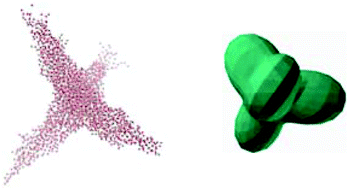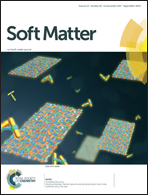When droplets become stars: charged dielectric droplets beyond the Rayleigh limit†
Abstract
When a nano-drop comprising a single spherical central ion and dielectric solvent is charged above a well-defined threshold, it acquires a stable star morphology. In contrast, conducting droplets, will undergo fission. Here we report combined atomistic molecular dynamics and continuum modelling study of star formation of droplets that contain a highly charged ion. We assume that in the continuum model the dielectric response is linear. In this linear continuum model, which is an extension of Rayleigh model, the energy of the drop is comprised of terms analogous to those in Rayleigh model, which are surface energy and electrostatic energy of dielectric droplet charged by a central point charge. We present the stability analysis of the continuum model to determine the threshold of instability. Indeed we find that the model accounts well for the onset of the instabilities. Molecular dynamics show that the number of points of the star-shaped nano-drops depends only on the surface tension, dielectric constant and size of the droplet, and on the magnitude of the charge of the central ion, but not on its sign. Intuitively, it is expected that when a spherical dielectric drop becomes unstable it would transform into a non-spherical finite shape of the same volume as the initial spherical shape with the point charge located in the drop interior. To test whether the extended Rayleigh model can account for the observed droplet shapes, we performed numerical simulations of the linear continuum model. Contrary to the expectations, the simulations of the extended Rayleigh model does not reproduce the stable star shapes found in the atomistic simulations, not even when we account for the bending rigidity and spontaneous curvature of the surface. We argue that the assumption that the dielectric response is linear breaks down if the droplet surface approaches the central macro-ion, where the electric field strength is such that dielectric saturation sets in. We envisage that for certain solvents, these stars could be made permanent by cross-linking, opening the way to the production of a novel class of highly-non-convex colloids.



 Please wait while we load your content...
Please wait while we load your content...